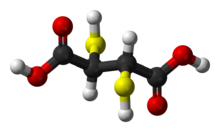Succimer
 |
|
 |
|
| Clinical data | |
|---|---|
| Pronunciation | succimer /ˈsʌksᵻmər/ |
| Trade names | Chemet, others |
| AHFS/Drugs.com | Monograph |
| Pregnancy category |
|
| ATC code | V03AB (WHO) |
| Identifiers | |
|
|
| Synonyms | (2R,3S)-2,3-Dimercaptosuccinic acid (no longer recommended) meso-2,3-Dimercaptosuccinic acid Succimer APRD01236 |
| CAS Number |
304-55-2 |
| PubChem (CID) | 2724354 |
| ChemSpider | 2006502 |
| UNII | DX1U2629QE |
| ChEMBL | CHEMBL1201073 |
| ECHA InfoCard | 100.005.597 |
| Chemical and physical data | |
| Formula | C4H6O4S2 |
| Molar mass | 182.22 |
| 3D model (Jmol) | Interactive image |
| Melting point | 125 °C (257 °F) |
|
|
|
|
Dimercaptosuccinic acid (DMSA), also called succimer, is a medication used to treat lead, mercury, and arsenic poisoning. When radiolabeled with technetium-99m, it is used in a number of types of diagnostic testing. It is taken by mouth for 19 days. More than two weeks should pass before a second course is given.
Common side effects include vomiting, diarrhea, rash, and low blood neutrophil levels. Liver problems and allergic reactions may also occur with use. It is unclear if use during pregnancy is safe for the baby. Dimercaptosuccinic acid is in the chelating agent family of medications. It works by binding with lead and a number of other heavy metals allowing them to leave the body in the urine.
Dimercaptosuccinic acid has been used medically since the 1950s. It is on the World Health Organization's List of Essential Medicines, the most effective and safe medicines needed in a health system. In the United States there was no generic version avaliable as of 2015. A course of treatment costs more than 200 USD (about 6.63 USD per 100 mg pill). In India it costs about 1.24 USD per 100 mg pill.
Dimercaptosuccinic acid is indicated for the treatment of lead poisoning in children with blood level measured above 45 µg/dL. The use of DMSA is not approved for prevention of lead poisoning in anticipation of exposure in known lead contaminated environments. Its elimination half-life is 2.5-3.5 h. DMSA can cross the blood–brain barrier of mice, but not that of humans, limiting its use to extracting heavy metals from parts of the body other than the central nervous system.
...
Wikipedia
